The Brazos Review: AMD's E-350 Supplants ION for mini-ITX
by Anand Lal Shimpi on January 27, 2011 6:08 PM ESTAMD has been curiously absent from the value netbook and nettop segments since Atom’s arrival nearly three years ago. These markets are highly profitable only for component vendors, as the OEMs that sell netbooks and nettops must survive on very slim margins in order to hit aggressive price points. It wasn’t too long ago that we were shocked by $699 desktop PCs, but to now be able to get a fully functioning portable PC with display at below $300 is impressive. In order for the profit equation to work out however, you can’t simply scale down a larger chip - you need an architecture targeted specifically at the type of very light workloads you expect to encounter in these segments. Underclocking and undervolting an architecture targeted at high end desktops or servers won’t cut it.
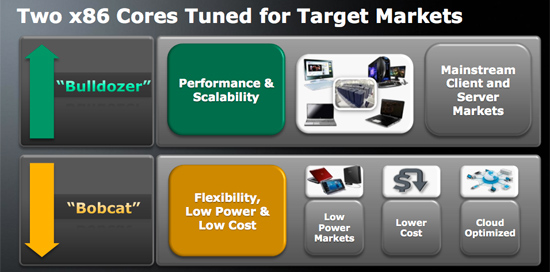
Generally a single microprocessor architecture can cover an order of magnitude of power envelopes. You can take an architecture from 10W - 100W using clock speed, voltage scaling and disabling features (e.g. cutting cache sizes). You can’t efficiently take a 100W architecture and scale it down to 1W. Intel realized this with Atom, and what resulted was a new architecture designed to span the 0.5W - 5W range. Given the constraints of the process (Atom was built at 45nm) and a desire to keep die size down to a minimum (and thus maximize profits), Intel went with a dual-issue in-order architecture reminiscent of the old Pentium - but with a modern twist.
AMD came to the same realization. For it to compete in these value markets, AMD couldn’t rely on its existing Phenom II derived architectures. The Phenom II and its relatives currently span a range of TDPs from 9W to 140W, and at the lower end of that spectrum we’re talking about some very low clock speeds and performance targets. Getting down to 1W was out of the question without a separate design.
What AMD came up with was a core called Bobcat, initially targeted for netbooks, notebooks, nettops and entry level desktops. Architecturally Bobcat is a significant step ahead of Atom: while still dual-issue, it features an out-of-order execution engine making it the Pentium Pro to Atom’s Pentium.
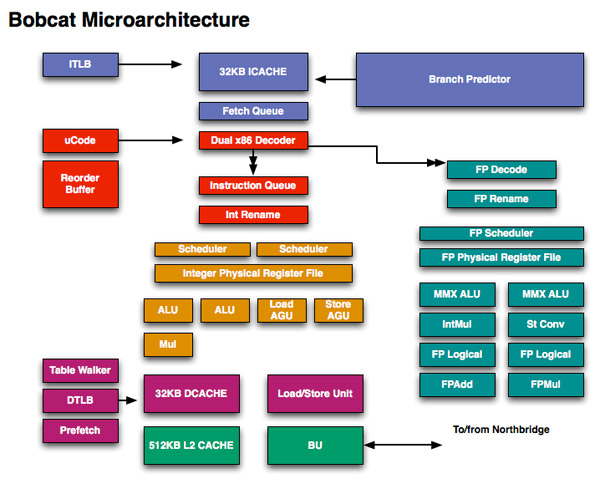
It isn’t just CPU architecture that AMD surpassed Atom with, the first incarnation of Bobcat is an integrated SoC with on-die DirectX 11 GPU. AMD calls this combination a Fusion APU (Accelerated Processing Unit) as it places both a CPU and GPU on a single die. The possible CPU/GPU combinations for Bobcat based APUs are listed in the table below:
| AMD Brazos Lineup | ||||||||
| APU Model | Number of Bobcat Cores | CPU Clock Speed | GPU | Number of GPU Cores | GPU Clock Speed | TDP | ||
| AMD E-350 | 2 | 1.6GHz | Radeon HD 6310 | 80 | 500MHz | 18W | ||
| AMD E-240 | 1 | 1.5GHz | Radeon HD 6310 | 80 | 500MHz | 18W | ||
| AMD C-50 | 2 | 1.0GHz | Radeon HD 6250 | 80 | 280MHz | 9W | ||
| AMD C-30 | 1 | 1.2GHz | Radeon HD 6250 | 80 | 280MHz | 9W | ||
AMD avoided branding its first APUs, they’re simply the AMD E-series and C-series Fusion APUs. The emphasis isn’t on the CPU or the GPU in this case, just the company name and a model number.
| CPU Specification Comparison | ||||||||
| CPU | Manufacturing Process | Cores | Transistor Count | Die Size | ||||
| AMD Zacate | 40nm | 2 | ? | 75 mm2 | ||||
| AMD Thuban 6C | 45nm | 6 | 904M | 346mm2 | ||||
| AMD Deneb 4C | 45nm | 4 | 758M | 258mm2 | ||||
| Intel Gulftown 6C | 32nm | 6 | 1.17B | 240mm2 | ||||
| Intel Nehalem/Bloomfield 4C | 45nm | 4 | 731M | 263mm2 | ||||
| Intel Sandy Bridge 4C | 32nm | 4 | 995M | 216mm2 | ||||
| Intel Lynnfield 4C | 45nm | 4 | 774M | 296mm2 | ||||
| Intel Clarkdale 2C | 32nm | 2 | 384M | 81mm2 | ||||
| Intel Sandy Bridge 2C (GT1) | 32nm | 2 | 504M | 131mm2 | ||||
| Intel Sandy Bridge 2C (GT2) | 32nm | 2 | 624M | 149mm2 | ||||
These APUs do need the aid of an additional chip - the Hudson Fusion Controller Hub (FCH). The FCH adds support for things like SATA, USB, Ethernet and Audio.The Hudson FCH is very tiny measuring approximately 4mm x 7mm for a total die size of around 28mm2.
The combination of these Bobcat based APUs and the FCH is called the Brazos platform.
Late last year AMD invited me to spend several hours with a Brazos system at its brand new campus in Austin, TX. While the preview gave us some insight into what we could expect from Brazos, I didn’t have enough time to really dive in as much as I would’ve liked to.
Earlier this month, AMD officially launched Brazos with hardware expected sometime this quarter. For the past couple of weeks I’ve been testing a Brazos mini-ITX motherboard from MSI and today, it’s time to break the silence and share the results. They are quite good.


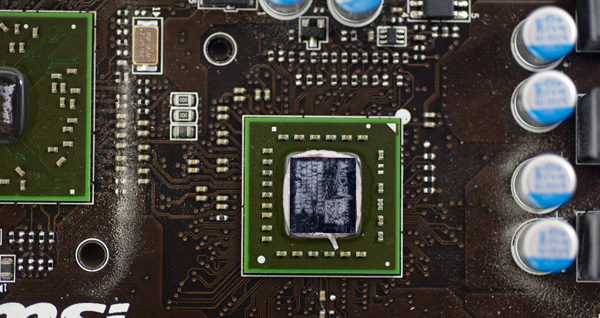
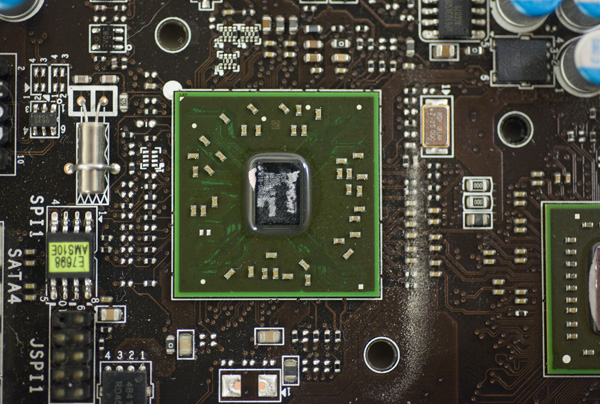
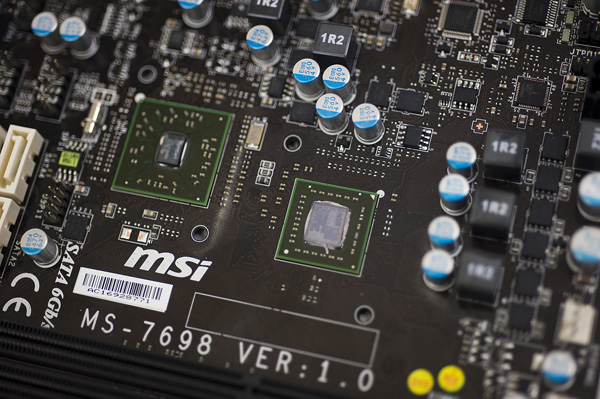
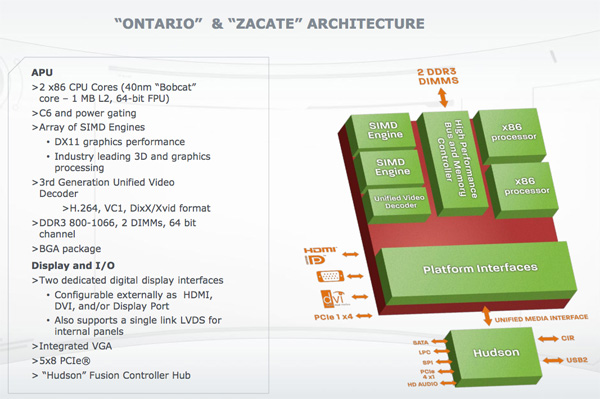








176 Comments
View All Comments
djfourmoney - Thursday, January 27, 2011 - link
You can build a sub-$350 HTPC with this! If you can recycle some parts from any of your other builds you might be able to get it under $300. I built a ASRock based HTPC based on the price expected for that board ($110) and it comes in at $319 before taxes and shipping. Careful shopping might avoid that.Run Mediabrowser with TV and GameTime! Plug-ins.
You can now throw away your Cable Box SD or HD. If you have standard cable, turning in your box and building a HTPC around one of these boards will pay for itself in about a year.
If you get HD and Premium Channels, hopefully SiliconDust's 3 Tuner CableCard adapter will be out before NFL Training Camp.
For Direct TV/Dish Network/AT&T U-verse, you'll be able to use Hauppauge Colossus with Component Input, eliminate issues with the HD-DVR USB version. As long as they don't cripple the component output, there's no PQ difference.
Khato - Thursday, January 27, 2011 - link
I've been somewhat disappointed with the lack of actual investigation into how changes in memory bandwidth affect this new generation of integrated GPUs - both on Brazos here as well as Sandybridge earlier. The direct comparison to a 5450 here is interesting, but since it wasn't stated I'm guessing those were stock 5450 numbers, not a 5450 underclocked to be the same frequency core/memory?The primary reason for it being a point of interest is that the current rumor has Llano at anywhere from 4x to 6x the shader resources, but only 2.4x the potential memory bandwidth. More likely 2x in any actual systems though given that anything above DDR3 1333 carries a decent premium. So if Brazos is already seeing hints of memory bandwidth limitations...
Anand Lal Shimpi - Thursday, January 27, 2011 - link
Those were stock 5450 numbers, and you are correct - memory bandwidth is an issue (one of Sandy Bridge's "tricks" is the shared L3 cache, it helps mask memory bandwidth limitations quite well as it is currently used for Z operations among other things). I expect that Llano will be much quicker than the E-350, remember that in many cases we're not necessarily GPU bound but rather CPU bound in these game tests.I will continue to play with performance on Brazos but I expect that once I've got Llano in house I'll be able to get a better idea of how bad the memory bandwidth limitations actually are.
Take care,
Anand
Khato - Friday, January 28, 2011 - link
Thanks for the reply. The CPU vs GPU bound comment actually sparked another point of curiosity - how does the performance picture change as resolution increases?There are quite a few games where the performance increase going from integrated to either the 5450 or 5570 is basically the same, implying that it's CPU limited and something about the integrated graphics decreases the performance. The unknown being whether that something is a constant, a slight latency hit due to whatever arbitration scheme is used between CPU and graphics for example, or if it will scale with the load placed upon the GPU, as would be the case for memory bandwidth.
This certainly has me looking forward to at last getting to see how Llano graphics performance is in a few months. I'd find it all too amusing if the better integration in Sandybridge resulted in graphics performance on par with a memory constrained Llano.
bjacobson - Saturday, January 29, 2011 - link
I was thoroughly surprised the e350 coped as well as the dedicated cards using shared RAM.Was not expecting that.
Speed3mon - Thursday, January 27, 2011 - link
this comment... kinda gay.. sry but trueAloonatic - Friday, January 28, 2011 - link
I don't think that even the staunchest homophobe would even go as far as to associate being gay with the nonsense that the OP wrote.It'[ a shame that there isn't a store that fanboys have to shop in, where their beloved companies can rip them off royally, as that seems to be their want.
His comment wasn't gay, it was just sad, and ill-conceived, which might be how their parents probably view them too, in hindsight :o)
etudiant - Thursday, January 27, 2011 - link
The Zacate die size is comparatively minute at 75mm2, about a quarter the size of the Thuban.That translates to perhaps one twentieth of the manufacturing cost, given yields are much better for smaller die. Should be very helpful for AMD if they can deliver in quantity.
GeorgeH - Thursday, January 27, 2011 - link
I'm very impressed. Does anyone have an idea when Intel and VIA might respond with updated products?Anand Lal Shimpi - Thursday, January 27, 2011 - link
Intel's 32nm Atom refresh will appear in Q4 2011.Take care,
Anand